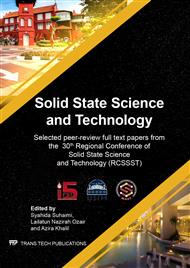[1]
B. Liu and H. C. Zeng, Hydrothermal synthesis of ZnO nanorods in the diameter regime of 50 nm, J. Am. Chem. Soc. 125 (2013) 4430-4431.
DOI: 10.1021/ja0299452
Google Scholar
[2]
D. Polsongkram, P. Chamninok, S. Pukird, L. Chow, O. Lupan, G. Chai, H. Khallaf, S. Park, and A. Schulte, Effect of synthesis conditions on the growth of ZnO nanorods via hydrothermal method, Phys. B: Condens. Matter 403 (2008) 3713–3717.
DOI: 10.1016/j.physb.2008.06.020
Google Scholar
[3]
M. Giannouli and F. Spiliopoulou, Effects of the morphology of nanostructured ZnO films on the efficiency of dye-sensitized solar cells, Renew. Energy 41 (2012) 115–122.
DOI: 10.1016/j.renene.2011.10.010
Google Scholar
[4]
Y. Bu, Z. Chen, W. Li, and B. Hou, Highly efficient photocatalytic performance of graphene-ZnO quasi-shell-core composite material, ACS Appl. Mater. Interfaces 23 (2013) 12361–12368.
DOI: 10.1021/am403149g
Google Scholar
[5]
P. M. Aneesh, K. A. Vanaja, and M. K. Jayaraj, Synthesis of ZnO nanoparticles by hydrothermal method, Nanophotonic materials IV 6639 (2007) 66390J.
DOI: 10.1117/12.730364
Google Scholar
[6]
J. Chung, J. Lee, and S. Lim, Annealing effects of ZnO nanorods on dye-sensitized solar cell efficiency, Phys. B: Condens. Matter 405 (2010) 2593–2598.
DOI: 10.1016/j.physb.2010.03.041
Google Scholar
[7]
Y. Wang, Y. Sun, and K. Li, Dye-sensitized solar cells based on oriented ZnO nanowire-covered TiO2 nanoparticle composite film electrodes, Mater. Lett. 63 (2009) 1102–1104.
DOI: 10.1016/j.matlet.2009.02.044
Google Scholar
[8]
F. Xu, M. Dai, Y. Lu, and L. Sun, Hierarchical ZnO Nanowire - Nanoflower Architectures for High Power Conversion Efficiency in Dye-Sensitized Solar Cells, J. Phys. Chem. C 114 (2010) 2776–2782.
DOI: 10.1021/jp910363w
Google Scholar
[9]
Y. Xi, W. Z. Wu, H. Fang, and C. G. Hu, Integrated ZnO nanotube arrays as efficient dye-sensitized solar cells, J. Alloys Compd. 529 (2012) 163–168.
DOI: 10.1016/j.jallcom.2012.02.183
Google Scholar
[10]
A. K. Geim and K. S. Novoselov, The rise of graphene., Nat. Mater. 6 (2007) 183–191.
Google Scholar
[11]
A. H. Castro Neto, N. M. R. Peres, K. S. Novoselov, and A. K. Geim, The electronic properties of graphene, Rev. Mod. Phys. 81 (2009) 109–162.
DOI: 10.1103/revmodphys.81.109
Google Scholar
[12]
J. D. Roy-Mayhew, D. J. Bozym, C. Punckt, and I. A. Aksay, Functionalized graphene as a catalytic counter electrode in dye-sensitized solar cells, ACS Nano 4 (2010) 6203–6211.
DOI: 10.1021/nn1016428
Google Scholar
[13]
D. W. Zhang, X. D. Li, H. B. Li, S. Chen, Z. Sun, X. J. Yin, and S. M. Huang, Graphene-based counter electrode for dye-sensitized solar cells, Carbon 49 (2011) 5382–5388.
DOI: 10.1016/j.carbon.2011.08.005
Google Scholar
[14]
J. Halme, Dye-sensitized nanostructured and organic photovoltaic cells: Technical review and preliminary tests - Master thesis submitted in partial fulfillment of the requirements for the degree of Master of Science in Technology Supervisor: Professor Peter Lun," Helsinki University of Technology (2002).
Google Scholar
[15]
J. Gong, J. Liang, and K. Sumathy, Review on dye-sensitized solar cells (DSSCs): Fundamental concepts and novel materials, Renew. Sustain. Energy Rev. 16 (2012) 5848–5860.
DOI: 10.1016/j.rser.2012.04.044
Google Scholar
[16]
A. Jena, S. P. Mohanty, P. Kumar, J. Naduvath, V. Gondane, P. Lekha, J. Das, H. K. Narula, S. Mallick, and P. Bhargava, Dye Sensitized Solar Cells: A Review, Trans. Indian Ceram. Soc. 71 (2012) 1–16.
DOI: 10.1080/0371750x.2012.689503
Google Scholar
[17]
M. R. Narayan, Review: Dye sensitized solar cells based on natural photosensitizers, Renew. Sustain. Energy Rev. 16 (2011) 208–215.
Google Scholar
[18]
S. Ameen, M. S. Akhtar, M. Song, and H. S. Shin, Vertically aligned ZnO nanorods on hot filament chemical vapor deposition grown graphene oxide thin film substrate: solar energy conversion, ACS Appl. Mater. Interfaces 4 (2012) 4405–12.
DOI: 10.1021/am301064j
Google Scholar
[19]
D. I. Son, B. W. Kwon, D. H. Park, W.-S. Seo, Y. Yi, B. Angadi, C.-L. Lee, and W. K. Choi, Emissive ZnO–graphene quantum dots for white-light-emitting diodes, Nat. Nanotechnol. 7 (2012) 465–471.
DOI: 10.1038/nnano.2012.71
Google Scholar
[20]
Z. Zhang, L. Ren, W. Han, L. Meng, X. Wei, X. Qi, and J. Zhong, One-pot electrodeposition synthesis of ZnO/graphene composite and its use as binder-free electrode for supercapacitor, Ceram. Int. 41 (2014) 4374–4380.
DOI: 10.1016/j.ceramint.2014.11.127
Google Scholar
[21]
T. Lu, Y. Zhang, H. Li, L. Pan, Y. Li, and Z. Sun, Electrochemical behaviors of graphene– ZnO and graphene–SnO2 composite films for supercapacitors, Electrochim. Acta 55 (2010) 4170–4173.
DOI: 10.1016/j.electacta.2010.02.095
Google Scholar
[22]
H. W. Wang, Z. A. Hu, Y. Q. Chang, Y. L. Chen, Z. Y. Zhang, Y. Y. Yang, and H. Y. Wu, Preparation of reduced graphene oxide/cobalt oxide composites and their enhanced capacitive behaviors by homogeneous incorporation of reduced graphene oxide sheets in cobalt oxide matrix, Mater. Chem. Phys. 130 (2011) 672–679.
DOI: 10.1016/j.matchemphys.2011.07.043
Google Scholar
[23]
S. Park, J. W. Suk, J. An, J. Oh, S. Lee, W. Lee, J. R. Potts, J. H. Byun, and R. S. Ruoff, The effect of concentration of graphene nanoplatelets on mechanical and electrical properties of reduced graphene oxide papers, Carbon 50 (2012) 4573– 4578.
DOI: 10.1016/j.carbon.2012.05.042
Google Scholar
[24]
F. Xu, J. Chen, X. Wu, Y. Zhang, Y. Wang, J. Sun, H. Bi, W. Lei, Y. Ni, and L. Sun, Graphene Scaffolds Enhanced Photogenerated Electron Transport in ZnO Photoanodes for High-Efficiency Dye-Sensitized Solar Cells, J. Phys. Chem. C 117 (2013) 8619– 8627.
DOI: 10.1021/jp312379b
Google Scholar
[25]
L. W. Hu, H. Tian, Y. X. Zhang, K. Lu, and A. H. Jing, ZnO/Graphene Composites: Synthesis, Characterization and Optical Properties, Key Eng. Mater. 609–610 (2014) 76–81.
DOI: 10.4028/www.scientific.net/kem.609-610.76
Google Scholar


